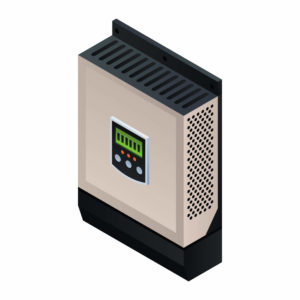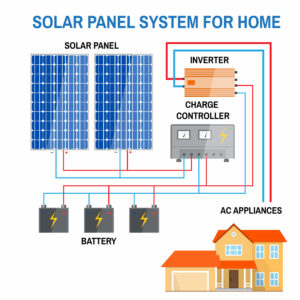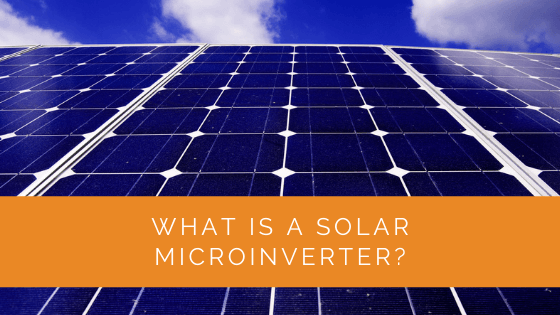Solar power systems are an excellent investment that can help you save a lot of money on electric bills in the long run. However, you have to make many decisions when designing the ideal solar power system for yourself, such as power capabilities, price, warranties, etc. Still, there’s one decision that looms the largest, which is the choice of an inverter.
Contents
- 1 Key Takeaways
- 2 The Role of Solar Inverters
- 3 What Is a Solar Microinverter?
- 4 How Does a Solar Microinverter Work?
- 5 String Inverters Vs. Solar Microinverters
- 6 What Are the Benefits of Solar Microinverters?
- 7 Case Study: Maximizing Solar Energy Efficiency with Microinverters
- 8 Expert Insights From Our Solar Panel Installers About Solar Microinverters
- 9 Experience Solar Excellence with Us!
- 10 Final Thoughts
Key Takeaways
- A solar microinverter is a small inverter attached to individual solar panels, allowing each panel to work independently to convert DC power to AC power.
- Solar microinverters offer benefits such as greater efficiency, higher overall solar system yields, less visible equipment, no single point of failure, precise remote monitoring, easy and faster installation, extended warranty coverage, and expandability.
- Compared to string inverters, microinverters are a preferable choice for complicated solar installations, areas with shading, and those seeking enhanced safety due to their elimination of high-voltage DC wiring.
The Role of Solar Inverters
Inverters play a critical role in the production of solar energy, which is why you need to choose the right one. When sunlight hits the solar panels, light energy is transformed into direct current (DC) power. However, since your home or business runs on alternating current (AC) power, a solar inverter is necessary. The inverter converts the DC into AC that can be used to run appliances.
Today, there are two main types of solar inverters that you can use with your solar power system – string inverters and microinverters.
Depending on various factors such as your energy needs, location, energy usage patterns, and the amount of shading on your home, one type of inverter could be better suited to your system than the other.
What Is a Solar Microinverter?
A solar microinverter is a tiny inverter designed to be attached to each individual solar panel. It accepts each panel’s current individually as opposed to a series of panels collectively, as is the case with a string inverter.

How Does a Solar Microinverter Work?
A solar microinverter performs the same role as a string inverter, but it is usually much smaller and designed to sit underneath each individual solar panel.
This is much different from a string solar inverter usually located on a wall some distance from the string of solar panels and connected using DC cable.
In a string inverter system, DC power from the string of solar panels is converted to AC by the inverter. In contrast, since solar microinverters are attached to individual solar panels, each panel works independently from the rest of the solar array. DC power is immediately converted to AC power right on the roof.
Since each microinverter operate independently of the other microinverters in the system, microinverters are considered module-level power electronics. This makes them an ideal solution for complicated solar power installations or those areas that experience marginal shading.
With string inverters, solar panels can only produce electricity at the level of the lowest-performing panel on the same string. However, that isn’t an issue with microinverters since each panel has its own inverter. So, the solar panels will keep performing efficiently even if one panel in the system is not producing electricity.
The size of each microinverter depends on the size of the solar panel and the amount of electricity it can produce as determined by the direction it is facing, the tilt, your geography, and more. If your panel produces more electricity than its microinverter can convert at a given time, “clipping” occurs, which results in power losses.
String Inverters Vs. Solar Microinverters
Suppose you are considering installing a solar power system on your home or business. In that case, one of the critical decisions you will need to make is whether to install a string inverter or a microinverter. Keep reading to understand the difference between the two and know how to choose the right one for your needs.
What Is a String Inverter?
A string inverter, or a central inverter is a large box that’s typically located on the wall on the outside of your property, or close to your electricity meter/fuse box. Each small-scale solar installation usually has one or two string inverters that operate in a series array or series circuit.
What Are the Benefits of Solar Microinverters?
Here are the top benefits of solar microinverters:
Greater Efficiency of Your Solar Energy System
When using a solar microinverter, each solar panel produces electricity independent of the rest, which means that each panel’s performance does not affect that of the neighboring panel.
So, a damaged or shaded solar panel won’t necessarily affect the performance of other panels since they work independently, which isn’t the case with a string inverter.
Higher Overall Solar System Yields
Solar microinverter have higher overall solar system yields compared to string inverter systems installed in similar conditions. Microinverters usually shine where shading is a problem, but they also usually deliver higher overall energy yields compared to string inverter systems when conditions such as access to sun, tilt angle, and orientation are ideal.
Less Visible Solar Energy Equipment
A string inverter is usually installed close to the utility meter, either outside a home or inside the garage. Some models end up taking up a lot of space, and many tend to be rather unsightly.
However, when it comes to microinverters, the vast majority of the equipment is high up the roof with the solar panels out of view.

No Single Point of Failure
The great thing with using a microinverter system is that even if one solar panel or microinverter fails, the remainder of the system will keep generating electricity.
In contrast, if you are using a traditional string inverter system and it goes down, it will most likely take the entire system down with it, thus producing no electricity at all.
Precision Remote System Monitoring
If you install a string inverter, you can track the energy production of your entire home solar power system. However, if you are using a microinverter, you can precisely monitor each module’s electricity output. Remote monitoring is even possible via the web to see how each panel is performing from anywhere with an Internet connection.
Easy and Faster Installation
Microinverters are individually attached to each of the photovoltaic panels that comprise your solar power system. Since the panels are not wired together in strings, and there aren’t any specific restrictions when it comes to solar panel orientation, the installation process is usually faster, thus translating to savings on labor charges.
Extended Warranty Coverage
Warranties for string inverters provide coverage for anywhere between 5 and 10 years since those parts can wear out by then. On the other hand, microinverters usually come with 25-year warranties due to their extended lifespans. If you want photovoltaic components that last, it is best to choose microinverters.
Easily Expandable
Are you looking to add on to your solar power system at some point in the future? If you are like some homeowners, you will probably start with a smaller photovoltaic array and expand it later as your budget allows. If you prefer that option, you should consider installing microinverters that allow for easier expansion.
Enhanced Safety
Solar panels using a string inverter are connected in series before being fed into the central inverter, with an effective nominal rating for 300 to 600 volts of direct current (VDC). That current is potentially life-threatening. Microinverters eliminate the need for high voltage DC wiring, thus improving the safety of both system owners and installers.
Case Study: Maximizing Solar Energy Efficiency with Microinverters
Background
At Solar Panels Network USA, we strive to provide our clients with the most efficient and reliable solar power solutions. This case study highlights the implementation of solar microinverters in a residential solar power system, demonstrating their effectiveness in optimizing energy production and system performance.
Project Overview
Our client, a homeowner with a moderately shaded roof, wanted to install a solar power system that could maximize energy production despite the shading issues. Given the specific conditions of the site, we recommended using solar microinverters to ensure each panel’s efficiency was not compromised by shading.
Implementation
We began by conducting a detailed site assessment to understand the shading patterns and potential energy production. The assessment included analyzing the roof’s orientation, tilt, and the extent of shading throughout the day.
Detailed Process
System Design and Planning: The system was designed to include 16 solar panels, each equipped with its own microinverter. This setup allowed each panel to operate independently, ensuring that shading on one panel would not affect the others.
Installation: The solar panels and microinverters were installed on the roof, with careful attention to minimizing shading impact. The microinverters were mounted underneath each panel, converting DC power to AC right at the source.
Optimization and Testing: After installation, the system was thoroughly tested to ensure all microinverters were functioning correctly. Performance monitoring software was set up to provide real-time data on each panel’s output, allowing for precise tracking and troubleshooting.
Maintenance and Monitoring
A comprehensive maintenance and monitoring plan was established to ensure the system’s long-term efficiency:
Regular Inspections: Periodic inspections were scheduled to check for any signs of wear, damage, or debris on the panels and microinverters. This proactive approach helped in identifying potential issues early.
Performance Monitoring: The performance of each panel was continuously monitored using the installed software. This allowed the homeowner to track energy production and usage, ensuring the system was operating at peak efficiency.
Cleaning Procedures: The panels were cleaned regularly to remove dust and debris, which could reduce their efficiency. Non-abrasive materials and techniques were used to avoid damaging the panels and microinverters.
Results
The implementation of the solar microinverter-based system resulted in significant energy savings for the homeowner. Despite the shading issues, the system generated enough electricity to cover approximately 85% of the household’s energy needs, leading to a substantial reduction in utility bills. The homeowner reported enhanced system performance and ease of monitoring, confirming the effectiveness of the microinverters.
Summary
This case study demonstrates the effectiveness of solar microinverters in optimizing energy production for solar power systems in shaded areas. By allowing each panel to operate independently, microinverters ensured maximum efficiency and reliability. Regular maintenance and monitoring further contributed to the system’s long-term performance, providing the homeowner with a sustainable and cost-effective energy solution.
Expert Insights From Our Solar Panel Installers About Solar Microinverters
Solar microinverters are a game-changer for solar power systems, especially in areas with shading. They allow each panel to operate independently, ensuring maximum efficiency even if one panel’s output drops.
Senior Solar Installer
One of the key benefits of microinverters is their ability to provide precise performance monitoring for each solar panel. This makes it easier to identify and troubleshoot issues, ensuring your system runs smoothly and efficiently.
Lead Solar Technician
Microinverters offer enhanced safety by eliminating the need for high-voltage DC wiring. This not only improves safety for installers but also for homeowners, making them a preferable choice for many solar installations.
Solar System Engineer
Experience Solar Excellence with Us!
Trust in Solar Panels Network USA, where our seasoned experts deliver top-quality solar solutions for homes and businesses nationwide. With a legacy of countless successful installations and a commitment to sustainable energy, we’re your reliable partner in the solar journey. Ready for a brighter, eco-friendly future? Call us now at (855) 427-0058 and harness the power of the sun!
Final Thoughts
You need to consider many factors when choosing the right type of inverter for your needs. Your solar installer will need to consider the direction your roof is facing, how much shade it is receiving, your energy production goals, and much more prior to determining which type of inverter is right for your system.
String inverters and microinverters both have their benefits and drawbacks. However, if you closely look at the benefits of microinverters, it is pretty clear that they are the clear winner.
So, if you are looking to build a robust solar power system, you should seriously consider using solar microinverters.
About the Author
Solar Panels Network USA stands at the forefront of solar energy solutions, driven by a team of seasoned solar engineers and energy consultants. With over decades of experience in delivering high-quality solar installations and maintenance, we are committed to promoting sustainable energy through customer-centric, tailored solutions. Our articles reflect this commitment, crafted collaboratively by experts to provide accurate, up-to-date insights into solar technology, ensuring our readers are well-informed and empowered in their solar energy decisions.

